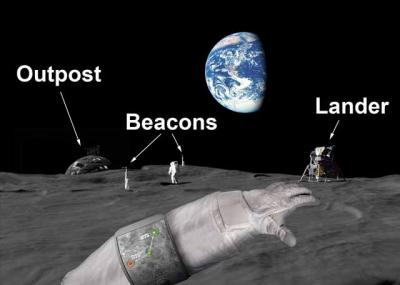
The Crazy Lune

 |
The Crazy Lune |
 |
|---|
      |
|
RF Hardware The receiver system of the telescope is design for simplicity. Since there are almost not interference on the surface of the moon as well as no FCC regulation on amount of power being transmitted the architecture design turn to be very straight forward. Direct conversion or Zero-IF architecture is chose. For the architecture RF spectrum is translated to the basedband in the first downconversion. It’s a cheap system due to lesser component as well as no special SAW filters are required as no image signal exists. The basic block diagrams for RF transceiver is shown below. |
|
Figure 4. RF Transceiver Architecture. As soon as the RF signal arrives its being pass through the Low Noise Amplifier (LNA) which amplifies the signal along with interference and noise; however, due to no interference exists on the Moon we chose LNA before bandpass filter (BPF) to obtain a good overall Noise figure. The LNA chosen has the ultra noise figure of 0.8 dB and 1 dB at operating frequency of 1.03 GHz and 2 GHz , respectively. LNA is followed by the BPF and Mixer where Mixer converts the RF signal to 70 MHz baseband signal. The baseband frequency was chosen based on the available ADC bit rate and SNR for processing as well as local oscillator. To boost the final to its finest level operational amplifier is used after the Mixer and finally before the signal is converted into Digital domain through ADC a low-pass filter (LPF) is used to remove any unwanted spurs to obtain overall high SNR at ADC. Figure 5. shows the basedband processing of the signal that pass through ADC, FPGA, and finally to compact PCI for further processing and extraction. Similarly, on the transmitter side the signal is generated in the digital domain and upconvert to baseband signal using DAC which than passes through a Mixer and BPF to convert the baseband signal to the RF signal and remove spurs generated by the Mixer. Finally the RF signal is amplified greatly using power amplifier. For 2 GHz operating frequency used between lander and astronaut a regular 5W surface mount PA is used and works perfectly. However, for astronaut to RFID link a broadband high power amplifier the delivers up to 60W of output power is required to obtain the extra bit of range. A UK based company named Amplifier Technology already develops 0.52 – 2.55 GHz, 60W broadband power amplifier the can be readily used for the project. By using 60W PA verses 5W PA the RFID range as well as accuracy is increase drastically. Datasheets specification for the RF hardware devices and baseband hardware can be found here. The following are the specifications for the RF hardware used on the astronaut to lander link: Tphy=93 K; Physical temperature on Moon's Surface NFP=1.8 dB; Noise Figure for the Power Splitter GP=-3 dBi; Gain of the Power Splitter NFLNA=1 dB; Noise Figure for the Low Noise Amplifier GLNA=14.9 dBi; Gain of the Low Noise Amplifier NFBPF=1.9 dB; Noise Figure for the Band Pass Filter GBPF=-2 dBi; Gain of the Band Pass Filter NFMIXER=7 dB; Noise Figure for the Mixer GMIXER=-6.5 dBi; Gain of Mixer NFPA=5 dB; Noise Figure of the Power Amplifier GPA=15.5 dBi; Gain of the Power Amplifier A physical temperature of 93 K is chosen, since the astronaut will be operating in the lunar night (Jiahui Yuan; Cressler, J.D.; Yan Cui; Guofu Niu; Finn, S.; Joseph, A., "On the profile design of SiGe HBTs for RF lunar applications down to 43 K," Bipolar/BiCMOS Circuits and Technology Meeting, 2008. BCTM 2008. IEEE, pp.25-28, 13-15 Oct. 2008). The effective system temperature is calculated according to the following expression:
Finally, the received noise power can be determined from the signal bandwidth and the system temperature,
Once the received power is known, the carrier-to-noise ratio is given as
|
Home | Project | Communication | Location | Power | Budget & Timeline Tuesday, December 8, 2009 © 2009 The Crazy Lune. All rights reserved. |